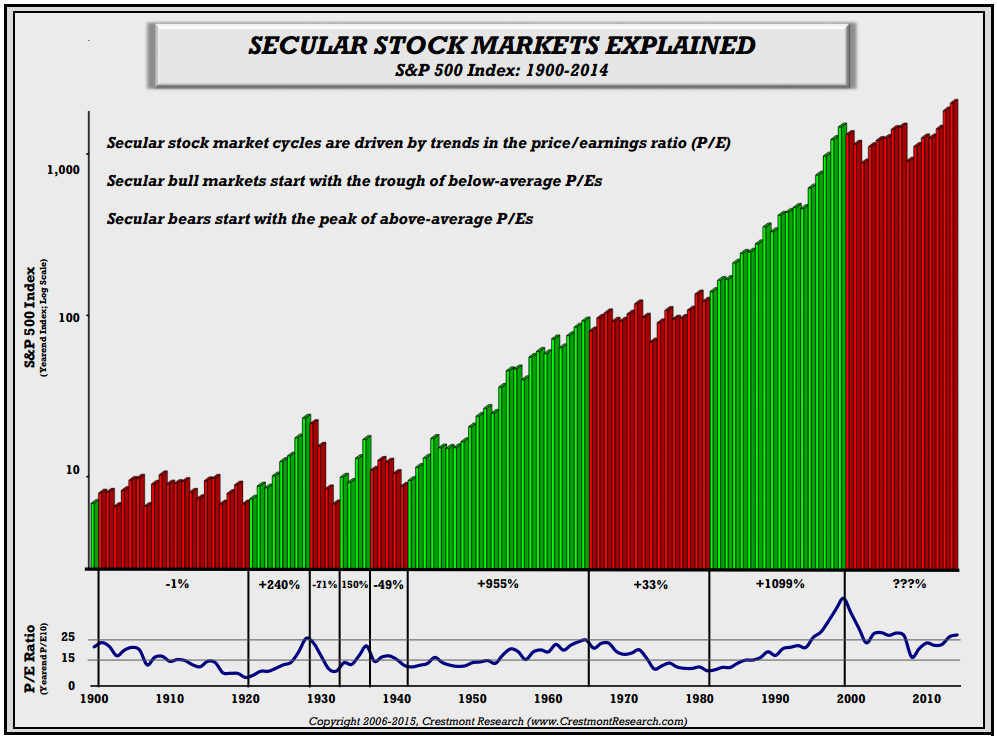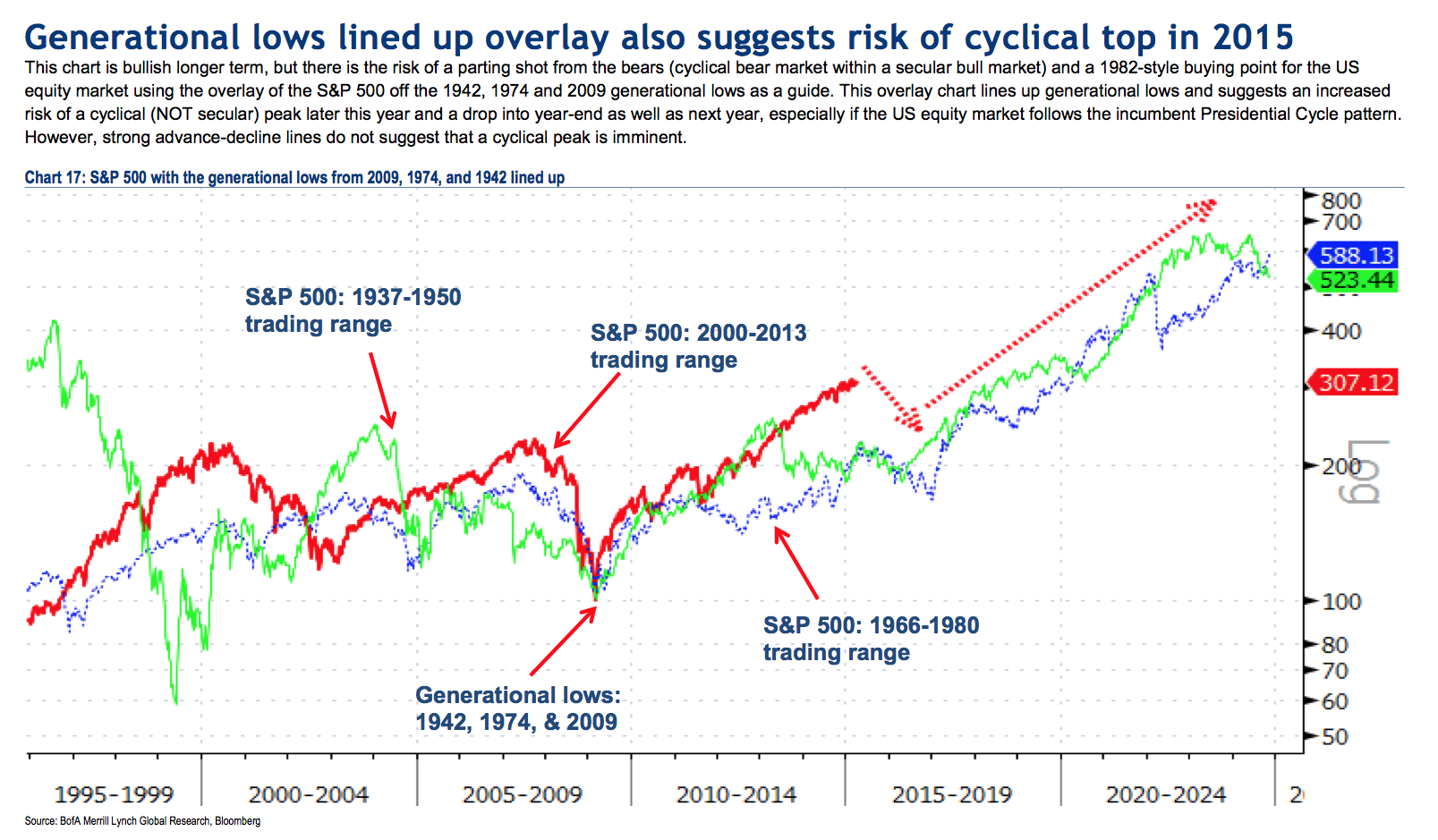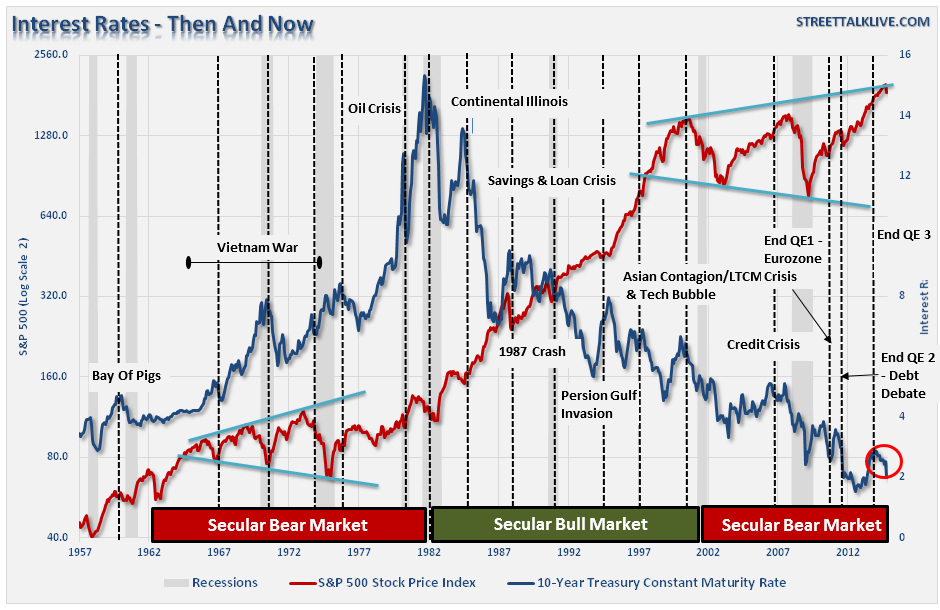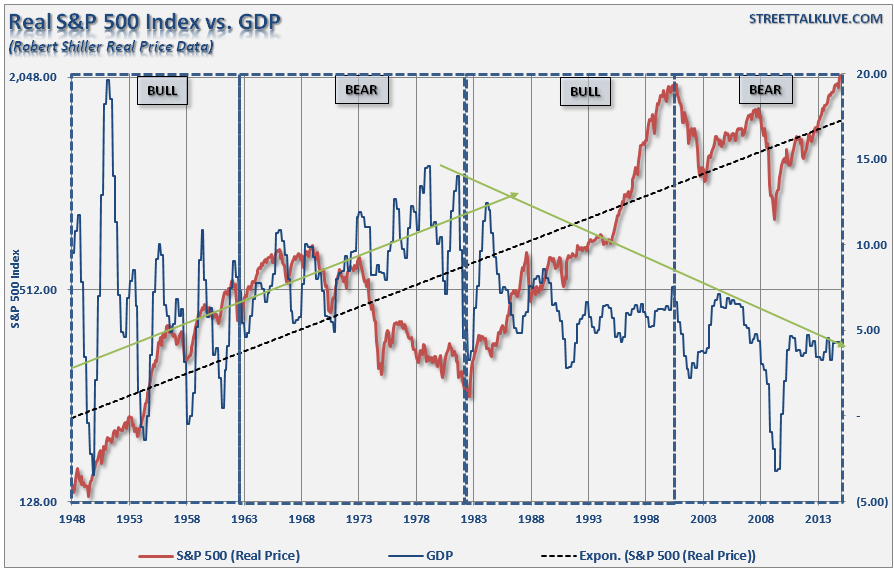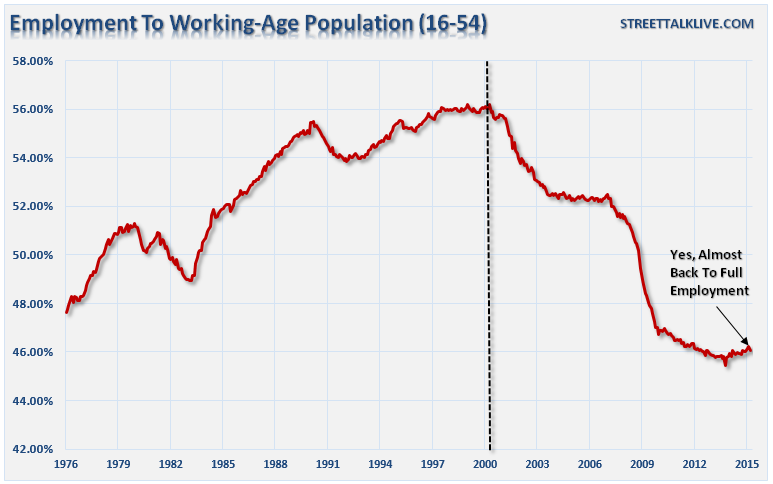Over the past couple of years, there has been a growing chorus of individuals claiming that the financial markets have finally shaken the shackles of the secular bear market that began at the turn of the century. This, of course, suggests that the markets have now begun the next long-term secular bull market.
The following chart, via Crestmont Research, is a quick primer if you are unfamiliar with secular, or long-term, periods in the financial markets.
Bank of America (NYSE:BAC) is the latest to jump onto the "new secular bull market" bandwagon with the following piece of analysis.
As of late, more strategists are beginning to argue that 2009 was a "generational low point" and that the markets are currently in the middle phase of a long-term, multiyear, secular bull market.
While anything is certainly possible, simply finding chart patterns that resemble each other is pretty poor analysis. How many charts have we seen over the year of "this market looks like 1929" for example?
Secular bull markets are not born of price, but rather of a set of fundamental metrics that foster sustained economic growth over long periods of time.
BofA's view is that the market bottomed in 2009 and that the current bull market is secular, not cyclical (short-term), in nature. Secular bull markets — like from 1942 to 1968 and 1982 to 2000 — are extended bull markets characterized by above-average annualized returns and generally less-dramatic downside risk.
BofA's analysis of time frames provides the context around which a secular market period exists. It is from that view that we can do some comparative analysis to determine if the "ingredients" that spurred the previous two secular bull market periods exists today.
Then And Now
Valuations
Valuations are currently pushing more than 27x earnings on a trailing basis using Dr. Shiller's cyclically adjusted methodology and at the second highest level in history. However, even if you want to discount Shiller's methodology (see here and here why you shouldn't) there are many other measures that confirm the same (see here). At the beginning of each previous secular bull market valuations were in the single digits. I have notated when valuations have exceeded 25x trailing earnings which historically marked the peaks of bull markets rather than the beginning.
Here is another view of valuations and secular market periods for a better perspective of future expected returns. The yellow triangles note valuations where secular bull markets previously began. Importantly, note the market's behavior at the start of periods where valuations were 25x earnings are higher.
Interest Rates
One of the key arguments behind the push in the markets over the last six years has been the artificially suppressed level of interest rates that are currently nearing their lowest levels since WWII. As shown in the chart below, interest rates rose during the secular bull market of the 40's and 50's as economic growth was strong enough, and steadily rising, to offset the drag of higher borrowing costs. Conversely, it was the fall of interest rates during the 80-90's that drove the secular bull market as financial deregulation spurred massive household credit expansion.
Inflation, Wages, Consumption & Debt
The following chart is the real key behind the secular periods of the financial market historically. During the post-WWII expansion, as the U.S. was the manufacturing center of the globe, wages and saving rates rose supporting consumption while household debt, a detraction from consumption, remained at fairly low levels. During the secular period of the 80-90's consumption was spurred by a massive increase in household credit while inflation, wages, and saving rates declined. Today, there is little ability for households to releverage themselves to support the consumption growth necessary for a continued and sustained secular period.
Economic Output
Economic growth is also another missing factor to the "secular" backdrop. During the 40-60's economic growth not only averaged above 6% annually, it was also in a steadily rising trend the supported higher levels of inflation, wage growth, and overall economic prosperity. While the secular bull market period of the 80-90's witnessed slower economic growth it remained above 4% as a surge in consumer credit, to fill the gap of rising living standards, drove consumption sharply higher (shown above). Today, with economic growth averaging just a bit more than 2% annually since the turn of the century, a primary driver of sustained returns is missing if the impact of Central Bank interventions is removed.
Employment
Lastly, employment is what ultimately leads to higher rates of sustained economic growth, consumption, and earnings for companies. Potentially the largest problem with the secular bull thesis currently is the structural shift in employment. Currently, there are more American's out of the labor force calculation, and on some form of government assistance, than ever before. To remove the argument of "baby boomers are retiring," I have stripped out individuals above the age of 55 to examine the employment-to-population ratio of individuals of prime working age (16-54.)
Conclusion
Could we be at the cusp of a new secular bull market as BofA suggests? That is really for you to decide.
However, my concern is that despite much hope that the current breakout of the markets is the beginning of a new secular "bull" market - the economic and fundamental variables suggest that this may not yet be the case. Valuations and sentiment are at very elevated levels which is the opposite of what has been seen previously. Interest rates, inflation, wages and savings rates are all at historically low levels which are normally seen at the end of secular bull market periods.
Lastly, the consumer, the main driver of the economy, will not be able to again become a significantly larger chunk of the economy than they are today as the fundamental capacity to releverage to similar extremes is no longer available.
The main problem with BofA's analysis of the current bull market trend, is the dismissal of the impact of coordinated global Central Bank interventions. There is a huge difference between an organically driven secular bull market in stocks supported by underlying economic strength as opposed to an asset price inflation derived from direct liquidity injections. The former is sustainable, the latter is only sustainable as long as the ability to continue to "juice" the markets remain.
The last point is key. Central Bank interventions are finite. There is a limit to the number of bonds that can be swapped for cash before the credit market seizes entirely. There is also a limit to the ability of the world to operate within the context of a negative interest rate environment.
While stock prices can certainly be driven much higher through global Central Bank interventions, the inability for the economic variables to "replay the tape" of the 80's and 90's increases the potential of a rather nasty mean reversion in the future. However, it is precisely such a reversion that will create the "set up" necessary to start the next great secular bull market. But as was seen at the bottom of the markets in 1942 and 1974, there were few individual investors left to enjoy the beginning of that ride.

